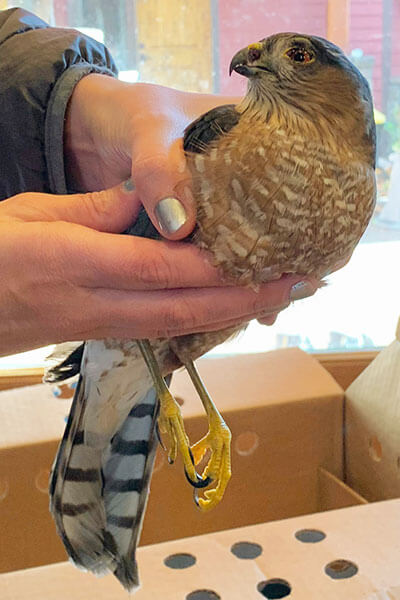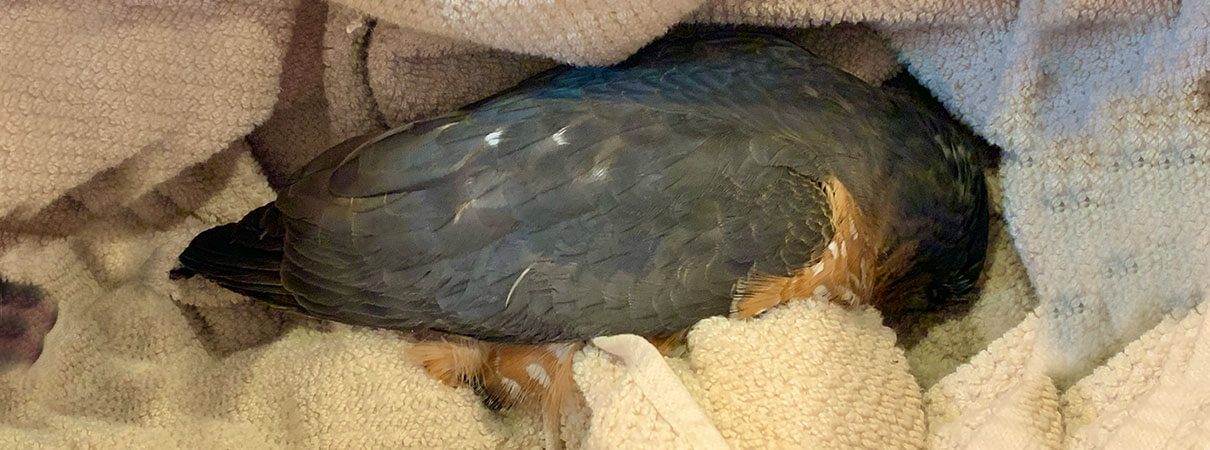A Piece of the Sky: Laura Hillenbrand Recounts Her Rescue of a Sharp-shinned Hawk
"[The bird] was, of course, a piece of the sky. His eyes said so. That is not a fact; this is the other part of knowing something, when there is no proof, but neither is there any way toward disbelief." – Mary Oliver

In the hush of the pandemic's beginning, the birds roused us. With businesses shuttered, roads vacant, the gnashing machinery of humanity halted, the world belonged again to them. Their quick bodies animated the stillness. Their voices, suddenly clear in the silence, were a high, bright summons to lift our heads from our grief, our loss, our loneliness, and awaken to all we had drowned out.
And so my boyfriend and I climbed in the car and began a daily ritual of drives into the tumbling vastness of Oregon, in search of solace. We'd follow whatever roads lured us, stop where the spirit moved us, and sit by rivers, in fields, in great mountain forests, our faces turned to the sky. As birds chattered and sang and swooped overhead, we lost ourselves in their gorgeous universe, high above our troubles.
On the early autumn morning when I first saw her, a dark lump by the fog line of a mountain highway, I thought she was a rock. Then a car roared within inches of her, and I saw feathers whirling, a small, hunkered-down body shuddering. I gasped. The lump was a Sharp-shinned Hawk, evidently struck by a car.
David pulled over, grabbed a towel from the back seat, and ran across the highway to her. Bloody and bewildered, she looked up at him as if with resignation. Ever so gently, he gathered her up in the towel and carried her to me.
I cradled her limp body in my arms, speaking softly to her, as we drove home. At the house, I nestled her in a cardboard box lined with towels. I called an animal rescue, the Rowena Wildlife Clinic, and then sat with her, stroking her lovely back, while I waited for them.
She lay face-down, eyes closed, her chest swelling and narrowing with jagged breaths. When the rescue worker lifted her, she raised her face, her bleeding eyes conveying a grief, a plaintiveness, that felled my heart. The rescue worker laid her in a cat carrier and took her away.
She dwelt in my mind. I kept texting the kind people at the rescue, asking about her. At first, she struggled. Her head was markedly swollen, her eyes protuberant, her balance so altered she could not perch. They gave her medication to ease the swelling and sat her on soft towels. She was unable to tear up meat, so they cut it up and hand fed it to her. They carried her back and forth to an enclosed area where she could try to fly. Slowly, she got better, standing ever-more firmly on her perch, testing her wings with growing assurance.
After two weeks, I got the message I'd hoped for: She was well, and we could come the next day to pick her up and set her free. Overjoyed, David and I spent the afternoon roaming bumpy little back roads far from the highways, searching for a new home for her.

The next morning, David picked up the hawk. With her in a cat box in the back seat, we headed off. Sometimes I could hear small, muffled knocks as she stirred against the cardboard, but I couldn't see her.
At last, we came to the place we'd chosen for her. It was in the remote foothills of Mount Hood, a patchwork of massive forests, orchards, broad fields over which she could hunt, towering pines in which she could perch, streams from which she could drink. We stopped at a clearing, where there were no fences she could strike when we freed her. With her box in the grass before me, I knelt.
Since we'd found her on the highway, I'd been unable to shake the image of her beleaguered face, in its sad surrender. When I opened the box and saw her again, I drew a sharp breath. She was transformed, shimmering, her eyes lit with the acute, imperious, unquenchable soul of her. A thrill pulsed through me, a sense of the exquisite privilege of being so close to her wondrous wildness. For a few breaths, she waited, those blazing eyes fixed on mine.
Then, whoosh! She swept up at the sun, her great wings unfolding, rejoining the light, strumming the air. Arcing over our heads, agile and dazzling and profoundly beautiful, she crossed over the field and vanished. She had become again a piece of the sky.
Note: Human rescuers have saved the lives of countless injured and sick animals, but be aware that most states and localities have specific guidelines pertaining to the capture and release of wildlife. If in doubt, please contact local authorities or rescue facilities before attempting to help birds or other wildlife.
 | Laura Hillenbrand is the author of numerous articles and books, including New York Times bestsellers Seabiscuit: An American Legend (2001) and Unbroken: A World War II Story of Survival, Resilience, and Redemption (2010). She currently lives in Oregon. |


















































